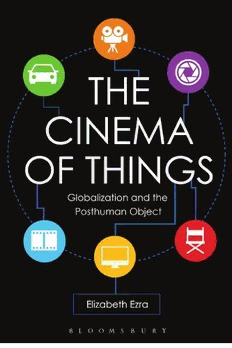
The cinema of things : globalization and the posthuman object PDF
Preview The cinema of things : globalization and the posthuman object
The Cinema of Things ii The Cinema of Things Globalization and the Posthuman Object Elizabeth Ezra Bloomsbury Academic An imprint of Bloomsbury Publishing Inc NEW YORK • LONDON • OXFORD • NEW DELHI • SYDNEY Bloomsbury Academic An imprint of Bloomsbury Publishing Inc 1385 Broadway 50 Bedford Square New York London NY 10018 WC1B 3DP USA UK www.bloomsbury.com BLOOMSBURY and the Diana logo are trademarks of Bloomsbury Publishing Plc First published 2018 © Elizabeth Ezra, 2018 All rights reserved. No part of this publication may be reproduced or transmitted in any form or by any means, electronic or mechanical, including photocopying, recording, or any information storage or retrieval system, without prior permission in writing from the publishers. No responsibility for loss caused to any individual or organization acting on or refraining from action as a result of the material in this publication can be accepted by Bloomsbury or the author. Library of Congress Cataloging-in-Publication Data A catalog record for this book is available from the Library of Congress. ISBN: HB: 978-1-5013-2885-5 ePDF: 978-1-5013-2882-4 ePub: 978-1-5013-2883-1 Cover design: Louise Dugdale Cover image © filborg/iStock Typeset by Deanta Global Publishing Services, Chennai, India To find out more about our authors and books visit www.bloomsbury.com. Here you will find extracts, author interviews, details of forthcoming events, and the option to sign up for our newsletters Contents Acknowledgments vi Introduction: Cinema, Globalization, and the Posthuman Object 1 1 Consuming Objects 31 2 Exotic Objects 67 3 Part-Objects 95 4 Objects of Desire 129 5 Posthuman Objects 159 Bibliography 183 Filmography 197 Index 201 Acknowledgments This book began life as a collaborative project with Terry Rowden. As sometimes happens with these things, Terry and I gradually came to the mutual realization that we were writing two different books, and we finally decided to let those books go their separate ways. Happily, this book still bears the hallmarks of Terry’s influence on nearly every single page, and I am enormously indebted to him for his unwavering intellectual support and friendship over the years, through various projects and across continents. It is no exaggeration to say that this book could not have been written without Terry. For their very helpful feedback on the manuscript, I would like to extend huge thanks in particular to Sue Harris, Ana Salzberg, and Maggie Flinn, as well as to an anonymous reviewer at the press. Conversations with Antonio Sanchez also sparked a number of ideas that have enriched the book. For their comments on various portions of the manuscript through the mists of time, I wish to thank Dudley Andrew, Tom Conley, Diana Holmes, Michael Rothberg, Max Silverman, and Carrie Tarr. I am also grateful to Katie Gallof at Bloomsbury for her enthusiasm and support for the project, which made all the difference. All translations from the French in this book not otherwise credited are my own. Any errors in this book are also my own. Portions of this manuscript have appeared in different forms in the following publications: Screen (“The Case of the Phantom Fetish: Louis Feuillade’s Les Vampires,” 2006, 47 [2]: 201–11), Yale French Studies (“Cléo's Masks: Regimes of Objectification in the French New Wave,” 2010, 118/119: 177–90), French Cultural Studies (“Posthuman Memory and the Re(f)use Economy,” 2014, 25 (3/4): 368–86), and A Belle Époque? Women and Feminism in French Society and Culture (“Becoming Women: Cinema, Gender and Technology”), ed. Diana Holmes and Carrie Tarr (New York and Oxford: Berghahn Books, 2006). I am grateful to the publishers for permission to reprint this material here. I am also pleased Acknowledgments vii to acknowledge receipt of a generous grant from the Leverhulme Trust, which allowed me to pursue research that proved vital for this project. My family has endured this book for what must seem like ages. My gratitude and love go to Simon, Nathan, and Paul, who constantly remind me that life is (mostly) other than what one writes. viii Introduction: Cinema, Globalization, and the Posthuman Object This book traces the progressive redrawing of the boundaries between humans and objects as represented in cinema from the end of the nine- teenth century, when French cinema dominated the global film industry, to the first decades of the twenty-first century, when Hollywood’s hold on world film markets remains firm, despite some important competition from other national cinemas. During this period, globalization has made it increasingly difficult to distinguish the center from the periphery, a pairing whose boundaries have been blurred by the overdetermined net- works of communication that crisscross the planet. This period also coin- cides with what Steven Connor calls “the thingly turn in recent theory” (Connor 2009: n.p.). Human beings relate to things, objects, and stuff in a number of ways: through hyperconsumption; through structures of racial and sexual objectification that reduce people designated as “oth- ers” to objects of fascination, sexual gratification, or labor; and through information technology that replaces human agency with encoding. By exploring the border zones between life (specifically human life) and nonlife, it is possible to gain an understanding of the ways that com- modities take on a life of their own, engulfing and ultimately replacing the people they were meant to supplement; of the exploitation of human beings for their use value as pure bodies, whether for entertainment, for labor, or in war time; and of the creation of technological supplementa- tion, digital worlds, and artificial life. It is possible, in other words, to gain an understanding of the ways in which humans are prosthetically engaged with life beyond the human in the global age. In virtual realms such as economics, communication, and the media, the obstructive force of national borders is becoming increasingly limited. Whereas transnationalism’s mandate is to reconfigure the nation into global viability, globalization’s mandate is to reduce the nation to
